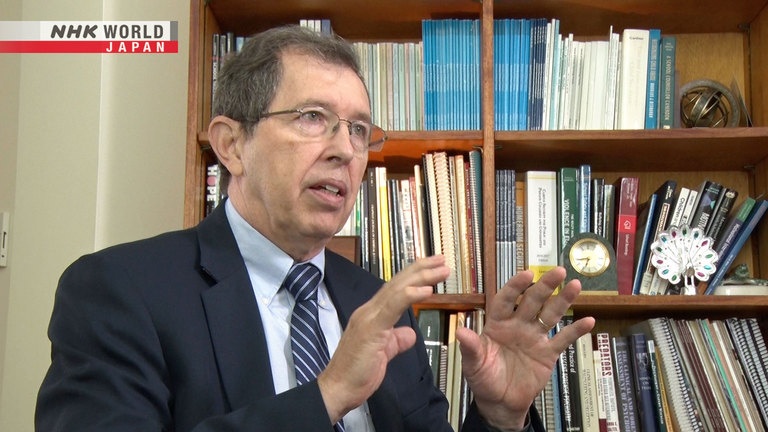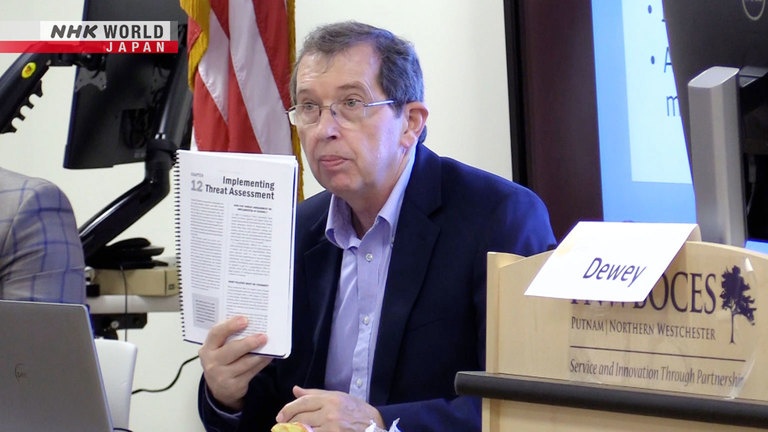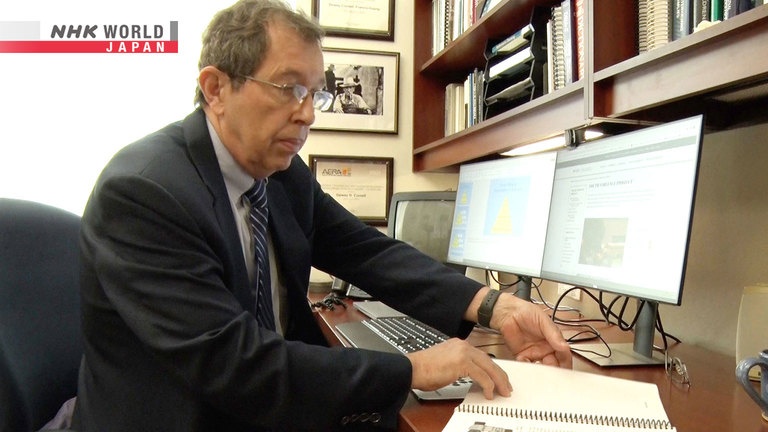The Key to Preventing School Shootings: Dewey Cornell / Forensic Clinical Psychologist
Dewey Cornell created a threat assessment program to prevent mass shootings in schools. It catches signs that a student is troubled and can help resolve issues before violent behavior starts.



Transcript
Direct Talk
Shootings in schools
have been a persistent problem
in the United States.
More than 330 incidents
have occurred since 1999,
killing at least 185 people.
Keeping students safe from school shootings
has become a critical issue in society.
One method that is attracting high hopes
is known as "threat assessment."
In the program, a team of
educators and counselors
looks into signs of threats
manifested by a student.
Dewey Cornell is a leading
threat assessment expert.
As a professor of clinical psychology
at the University of Virginia,
he created this comprehensive program,
which has been adopted by many states.
We ask Dewey Cornell
what he considers the key,
to reducing the risk of shootings in schools.
The Key to Preventing School Shootings
In a number of the shootings,
people knew.
The students had shared their intentions.
And so again, we need a
threat assessment team at the school
where students, teachers, and parents know
that they can go to the school
and say, "I'm worried."
"Here's what I saw."
"Here's what was said."
And then that team can investigate,
and when they do a good job,
they determine that a threat is
truly serious and can be stopped.
In workshops, Cornell shares
the methodology of threat assessment
to prevent school shootings.
It requires teachers,
counselors, school administrators,
and law enforcement officers,
to work together as a team.
I have had enough of this.
I'm going to shoot
every single last one of you.
When a potential threat is
reported by peers or others,
the team talks to the student
who made the threat
and looks carefully at his or her life.
Re-enactment in instructional video
Do you want to talk about it?
Well, kids on the bus,
they're always picking on me.
and even the bus driver doesn't stop them,
they never listened.
Then, the team evaluates the
seriousness of the student's behavior
and finds a way to resolve issues,
which led to the problem.
Re-enactment in instructional video
A 150-page manual outlines
the team's work, step-by-step.
including detailed questions for the team
to ask a student who is in trouble.
Although the process outlined
in the manual looks easy to follow,
it demands that team members
do some deep analysis.
There is no checklist that you can say,
oh, if they check these boxes, it's serious.
We must always look at
the context, the circumstances.
We look at the child's history.
We look at what witnesses have to say.
we have some standard questions that we ask,
but we make sure that we are thorough
and that we talk to other individuals
to understand the full circumstance.
Threat assessment is a heavy responsibility.
One teacher,
one counselor,
one principal is not enough.
It's too worrisome to have to
make such a decision on your own,
and you will be tempted to
just assume everyone is dangerous
and everyone should be
removed from the school
because you don't want to be wrong.
However, if we have a team,
we can share the responsibility.
A team can gather more information,
they can deliberate,
they can evaluate the information
and they can make a better decision.
Also when they decide that
the student needs services,
the team can get the
services for the student.
The school principal
can ask for the services.
The counselor can deliver the services.
The teacher can monitor
if the services are working.
The counselor can talk with the parents.
So we really need a team
to do all the things that we need
help the student and resolve the problem.
A big problem we have
is something called zero-tolerance.
Zero-tolerance is a
philosophy of harsh punishment,
no matter what circumstance.
Even if it's a silly behavior,
So a student said, "Pow, pow,"
with their finger,
suspended from school, out of school.
A student took out a pencil
and went "Pow, pow," with a pencil,
suspended from school.
We know that using this model
leads to more suspensions,
more misbehavior,
more academic failure,
more students drop out of school,
more students end up
in the criminal justice system.
So a zero-tolerance approach,
it might sound good,
but it doesn't work.
Cornell now has a staff of 18 people
conducting workshops
and research alongside him.
Their research shows
that the majority of threats
made by students
who received an assessment,
are never carried out.
Over the years, the program
has been introduced in 40 states.
It has prevented numerous incidents,
impacting the lives of countless students.
We have hundreds of cases
where a student makes a threat,
they see the threat assessment team.
A young man in a local school
was being teased by his peers.
He was being made fun of.
He had a speech problem,
he was awkward,
and so they were making fun of him.
And so he threatened
caused a big uproar.
Parents wanted the student
to be expelled from school.
The threat assessment team
looks at the situation.
He's upset,
he's distressed,
but he's not serious about killing someone.
And so they worked with him.
They worked with the students
who were teasing him.
He began to see the
counselor on a regular basis
and developed a good
relationship with the counselor.
And a year later,
there was a school shooting in the news
and he came to the counselor and said,
"Thank you."
"That could have been me,
and you helped me."
For Cornell, it was a 1997 mass school shooting
which influenced him to
start working on threat assessment.
As a forensic psychologist,
he researched the
14-year old student involved.
The student had been bullied
throughout childhood.
And one day, a group of students incited him
to take revenge on an opposing group.
The school did not do enough
to stop the bullying,
they looked the other way
and the bullying continued.
And he was physically bullied,
he was verbally bullied.
And he became depressed and withdrawn
and suicidal.
And he began to have delusions.
And he stole some guns.
He stole some guns from a neighbor.
And he told a number of his friends,
"I've got the guns."
And they said, "Well, we'll help you.
We'll see you Monday morning."
Now these boys say,
"No, we didn't say that."
"We were just joking, it wasn't serious,
we didn't think it would really happen."
And to friends that he was concerned about,
he said,
"Don't be in the lobby Monday morning."
So many kids were told
and nobody told an adult.
So when I hear this,
you can imagine it was heartbreaking
to realize it could have been prevented.
And this young man went to school,
And he by himself
fired into a crowd of students
and shot eight students
and...
and killed three young women.
So the FBI conference was in 1999.
And we thought, okay, what was the
difference between the shootings
that took place and the shootings
that were prevented?
The biggest difference is,
threats were reported.
In almost all of the shootings,
the student made threats.
They let people know
what they were planning to do.
They asked for help from other students.
They warned people,
they threatened people,
they wrote things on the internet about it.
But in the shootings
where the threats were not reported,
the shootings occurred.
Where the threats were reported
and investigated and found to be serious,
they were stopped.
Every time a school shooting happens,
there is an outcry calling for prevention.
But, nobody has ever reached
a consensus on what to do.
Many push for investing in security systems,
however, Cornell argues,
such a quick fix
will not reduce school shootings.
Prevention has to start
before the gunman arrives.
If we only think about the gunman,
then we only think about locking the door
and having an armed guard
and having a camera.
Very expensive,
very ineffective
and short sighted.
And they do that
because they think it's unpredictable.
And I say, yes, it's unpredictable.
I don't know where
the next shooting will occur,
but I can still prevent a shooting.
We don't have to know,
oh, you really are
going to commit a shooting.
No, we don't need to know that.
We just need to know,
you have a need.
There is a problem.
So threat assessment is
helping many thousands of students
and maybe only one in a million
would've committed a shooting.
But how do we prevent cancer?
We all stop smoking, you know.
I can't predict whether it's saved me or not,
but I'm going to do it
and it will work.
So prevention does not require prediction.
I don't want to label a student
and say, "You're a dangerous student,
you're a killer,"
anything like that.
I simply say,
"You're upset about something."
"You made a threatening statement."
"You're angry about something."
"You're hurt about something."
"What can we do to resolve the problem?"
In 2022,
a modest gun safety law
was finally passed in Congress
after years of struggle
and many mass shootings.
Gun laws are not going to
eliminate the problem,
but they will reduce it.
It's a risk factor.
And so like all illnesses
and public health problems,
there's no single solution
that eliminates the problem,
but there are ways to reduce it.
If we had reasonable gun safety laws,
we could greatly reduce
gun violence in our country.
And we need to do a much better job
of helping those individuals
to be more successful,
because if they were
successful in their life,
they wouldn't feel like
this is the only way that they can
end their life or carry out their life.
Most of the mass shootings
are not in schools.
The vast majority of
mass shootings are in homes,
public places like stores and restaurants,
parking lots,
concerts, many other places.
So we can't just focus on
the school shootings.
They're horrifying and they are upsetting
and they arouse our concern,
but the mass shootings are everywhere
and we need a solution
that is focused on all of them.
And that's by helping our young people
be happier and more successful in school
and then as young adults
after they leave school.
After decades of working on the
prevention of school shootings,
what does Dewey Cornell think is the
most important thing, for us to keep in mind?
So "Prevention does not require prediction."
There is a common misunderstanding
that because shootings are
unpredictable and unexpectable,
that there's nothing
we can do to prevent them.
No one can predict
who is going to get cancer,
but if you stop smoking,
your risk goes down.
So we just need to identify the risk factors,
and prevention will
take care of itself without prediction.
Prevention does not require prediction.